Adaptive Analysis of Green Space Network Planning for the Cooling Effect of Residential Blocks in Summer: A Case Study in Shanghai
Abstract
1. Introduction
2. The Case Study Region
3. Methodology
3.1. Simulation Model and Data
3.2. Validation of ENVI-Met Software
3.3. The Planning Scenarios and Spatial Subtraction Analysis
4. Results and Discussion
4.1. The Thermal Environment Distribution of the Current Situation
4.1.1. The Effect of Water Bodies
4.1.2. The Effect of Green Space
4.2. The Comprehensive Analysis of Cooling Effect in Different Scenarios
4.2.1. The Total Change of the Thermal Environment for Different Scenarios
4.2.2. The General Changes of the Cooling Effect with Different Scenarios
4.2.3. Spatial Distribution Trend of Cooling Effect from Different Scenarios
4.2.4. The Distribution Area Changes for Cooling Target Value from Different Scenarios
4.3. The Detailed Cooling Effect Distribution Analysis for Different Scenarios
4.3.1. The Cooling Effect of Single Spatial Structure for Different Scenarios
4.3.2. The Cooling Effect of Different Subzones in the Residential Block
5. Conclusions
Author Contributions
Funding
Acknowledgments
Conflicts of Interest
References
- IPCC. 2014: Climate Change 2014: Synthesis Report. Contribution of Working Groups I, II and III to the Fifth Assessment Report of the Intergovernmental Panel on Climate Change; Core Writing Team, Pachauri, R.K., Meyer, L.A., Eds.; IPCC: Geneva, Switzerland, 2014; p. 151. Available online: http://ar5-syr.ipcc.ch/ (accessed on 10 February 2016).
- Huang, W.; Li, J.; Guo, Q.; Mansaray, L.; Li, X.; Huang, J. A satellite-derived climatological analysis of urban heat island over shanghai during 2000–2013. Remote Sens. 2017, 9, 641. [Google Scholar] [CrossRef]
- Wang, J.; Yan, Z.; Quan, X.W.; Feng, J. Urban warming in the 2013 summer heat wave in eastern China. Clim. Dyn. 2017, 38, 3015–3033. [Google Scholar] [CrossRef]
- Aflaki, A.; Mirnezhad, M.; Ghaffarianhoseini, A.; Ghaffarianhoseini, A.; Omrany, H.; Wang, Z.H.; Akbari, H. Urban heat island mitigation strategies: A state-of-the-art review on Kuala Lumpur, Singapore and Hong Kong. Cities 2017, 62, 131–145. [Google Scholar] [CrossRef]
- Bhati, S.; Mohan, M. Wrf model evaluation for the urban heat island assessment under varying land use/land cover and reference site conditions. Theor. Appl. Climatol. 2016, 126, 385–400. [Google Scholar] [CrossRef]
- Mcguire, A.D.; Sitch, S.; Clein, J.S.; Dargaville, R.; Esser, G.; Foley, J. Carbon balance of the terrestrial biosphere in the twentieth century: Analyses of co2, climate and land use effects with four process-based ecosystem models. Glob. Biogeochem. Cycles 2001, 55, 183–206. [Google Scholar] [CrossRef]
- Shi, P.; Yi, Y.; Jin, C. The effect of land use on runoff in Shenzhen city of china. Acta Ecol. Sin. 2001, 2121, 1041–1049. [Google Scholar]
- Zibibulla, S.; Zhang, Y.F.; Yin, Z.G.; Zhang, J.; Paxiagu; Suliye; Zumiret. Relevance Analysis between Urbanization and Urban Land Use Change of Korla City. Xinjiang Agric. Sci. 2010, 4747, 1025–1029. [Google Scholar]
- Hara, Y.; Takeuchi, K.; Okubo, S. Urbanization linked with past agricultural landuse patterns in the urban fringe of a deltaic Asian mega-city: A case study in Bangkok. Landsc. Urban Plan. 2005, 7373, 16–28. [Google Scholar] [CrossRef]
- Lee, Y.Y.; Din, M.F.M.; Ponraj, M.; Noor, Z.Z.; Iwao, K.; Chelliapan, S. Overview of urban heat island (uhi) phenomenon towards human thermal comfort. Environ. Eng. Manag. J. 2017, 1616, 2097–2112. [Google Scholar]
- Sang, Y.F. Wavelet entropy-based investigation into the daily precipitation; variability in the Yangtze river delta, china, with rapid urbanizations. Theor. Appl. Climatol. 2013, 111, 361–370. [Google Scholar] [CrossRef]
- Zhu, Z.; Zheng, B. Study on spatial structure of Yangtze river delta urban agglomeration and its effects on urban and rural regions. J. Urban Plan. Dev. 2012, 138, 78–89. [Google Scholar]
- Xiong, Y.; Huang, S.; Chen, F.; Ye, H.; Wang, C.; Zhu, C. The impacts of rapid urbanization on the thermal environment: A remote sensing study of Guangzhou, China. Remote Sens. 2012, 44, 2033–2056. [Google Scholar] [CrossRef]
- Huang, Q.; Lu, Y. The effect of urban heat island on climate warming in the Yangtze river delta urban agglomeration in China. Int. J. Environ. Res. Public Health 2015, 12, 8773–8789. [Google Scholar] [CrossRef] [PubMed]
- Zhang, Y.; Bao, W.J.; Yu, Q.; Ma, W.C. Seasonal variation and interannual difference of heat island effect in mega-cities. J. Geophys. 2012, 55, 1121–1128. [Google Scholar]
- Giorgio, G.A.; Ragosta, M.; Telesca, V. Application of a multivariate statistical index on series of weather measurements at local scale. Measurement 2017, 112, 61–66. [Google Scholar] [CrossRef]
- Kundu, S.; Khare, D.; Mondal, A. Individual and combined impacts of future climate and land use changes on the water balance. Ecol. Eng. 2017, 105, 42–57. [Google Scholar] [CrossRef]
- Evans, E.; McGregor, G.R.; Petts, G.E. River energy budgets with special reference to river bed processes. Hydrol. Process. 1998, 12, 575–595. [Google Scholar] [CrossRef]
- Caissie, D. The thermal regime of rivers: A review. Freshw. Biol. 2006, 51, 1389–1406. [Google Scholar] [CrossRef]
- Gunawardena, K.R.; Wells, M.J.; Kershaw, T. Utilising green and bluespace to mitigate urban heat island intensity. Sci. Total Environ. 2017, 584–585, 1040–1055. [Google Scholar] [CrossRef] [PubMed]
- Gu, R.; Montgomery, S.; Austin, T.A. Quantifying the effects of stream discharge on summer river temperature. Hydrol. Sci. J. 1998, 43, 885–904. [Google Scholar] [CrossRef]
- Zhu, C.; Li, S.; Ji, P.; Ren, B.; Li, X. Effects of the different width of urban green belts on the temperature and humidity. Acta Ecol. Sin. 2011, 31, 383–394. [Google Scholar]
- Hathway, E.A.; Sharples, S. The interaction of rivers and urban form in mitigating the urban heat island effect: A UK case study. Build. Environ. 2012, 58, 14–22. [Google Scholar] [CrossRef]
- Steeneveld, G.J.; Koopmans, S.; Heusinkveld, B.G.; Theeuwes, N.E. Refreshing the role of open water surfaces on mitigating the maximum urban heat island effect. Landsc. Urban Plan. 2014, 121, 92–96. [Google Scholar] [CrossRef]
- Theeuwes, N.E.; Solcerová, A.; Steeneveld, G.J. Modeling the influence of open water surfaces on the summertime temperature and thermal comfort in the city. J. Geophys. Res. Atmos. 2013, 118, 8881–8896. [Google Scholar] [CrossRef]
- O’Malley, C.; Piroozfar, P.; Farr, E.R.P.; Pomponi, F. Urban heat island (uhi) mitigating strategies: A case-based comparative analysis. Sustain. Cities Soc. 2015, 19, 222–235. [Google Scholar] [CrossRef]
- Mou, I.Z.H.; Fahim, M.R. Relevance of Waterbody in Inducing Low Temperature in Residential Neighborhood: A Case of Dhanmondi, Dhaka. J. Modern Sci. Technol. 2013, 1, 157–166. [Google Scholar]
- Syafii, N.I.; Ichinose, M.; Wong, N.H.; Kumakura, E.; Jusuf, S.K.; Chigusa, K. Experimental study on the influence of urban water body on thermal environment at outdoor scale model. Procedia Eng. 2016, 169, 191–198. [Google Scholar] [CrossRef]
- Yoon, J.O.; Chen, H.; Ooka, R.; Kato, S.; Hsieh, C.M.; Ishizaki, R.; Miisho, K.; Kudoh, R. Design of the Outdoor Thermal Environment for a Sustainable Riverside Housing Complex Using a Coupled Simulation of cfd and Radiation Transfer. Available online: http://www.irbnet.de/daten/iconda/CIB8099.pdf (accessed on 5 September 2017).
- Lu, Y.M.; Wang, X.; Zhou, H.C. Numerical simulation of the adjustment Mechanism of water pond on microclimate in residential districts. Build. Sci. 2015, 31, 101–107. [Google Scholar]
- Zhou, H.C. Research on Local Climate Regulated by Water Pond in Residential Area. Master’s Thesis, Guangdong University of Technology, Guangzhou, China, 2014. [Google Scholar]
- Inard, C.; Groleau, D.; Musy, M. Energy balance study of water ponds and its influence on building energy consumption. Build. Serv. Eng. Res. Technol. 2003, 25, 171–182. [Google Scholar] [CrossRef]
- Zhang, X.C. Study on the Thermal Environment of Water-Shore Residence in Shenyang City. Master’s Thesis, Shenyang Architecture University, Shenyang, China, 2011. [Google Scholar]
- Wu, Z.; Kong, F.; Wang, Y.; Sun, R.; Chen, L. The impact of greenspace on thermal comfort in a residential quarter of Beijing, China. Int. J. Environ. Res. Public Health 2016, 13, 1217. [Google Scholar] [CrossRef] [PubMed]
- Herath, H.M.P.I.K.; Halwatura, R.U.; Jayasinghe, G.Y. Evaluation of green infrastructure effects on tropical Sri Lankan urban context as an urban heat island adaptation strategy. Urban For. Urban Green. 2018, 29, 212–222. [Google Scholar] [CrossRef]
- Ghani, A.N.A.; Ariffin, J.; Tukiran, J. A study on the cooling effects of greening for improving the outdoor thermal environment in Penang Malaysia. Int. J. GEOMATE 2017, 12, 62–70. [Google Scholar]
- Srivanit, M.; Hokao, K. Evaluating the cooling effects of greening for improving the outdoor thermal environment at an institutional campus in the summer. Build. Environ. 2013, 66, 158–172. [Google Scholar] [CrossRef]
- Lee, H.; Mayer, H.; Chen, L. Contribution of trees and grasslands to the mitigation of human heat stress in a residential district of Freiburg, southwest Germany. Landsc. Urban Plan. 2016, 148, 37–50. [Google Scholar] [CrossRef]
- Abreu-Harbich, L.V.D.; Labaki, L.C.; Matzarakis, A. Effect of tree planting design and tree species on human thermal comfort in the tropics. Landsc. Urban Plan. 2015, 138, 99–109. [Google Scholar] [CrossRef]
- Zheng, S.; Zhao, L.; Li, Q. Numerical simulation of the impact of different vegetation species on the outdoor thermal environment. Urban For. Urban Green. 2016, 18, 138–150. [Google Scholar] [CrossRef]
- Liu, Y.; Guo, J.; Wei, Q. Urban green space landscape patterns and thermal environment investigations based on computational fluid dynamics. Acta Ecol. Sin. 2012, 32, 1951–1959. [Google Scholar]
- Peng, L.L.H.; Jim, C.Y. Green-roof effects on neighborhood microclimate and human thermal sensation. Energies 2013, 6, 598–618. [Google Scholar] [CrossRef]
- Xuan, C.Y. Impact of Water Distribution on Atmospheric Environment in Urban Area. Mater’s Thesis, Lanzhou University, Lanzhou, China, 2011. [Google Scholar]
- Li, C.; Yu, C.W. Mitigation of urban heat development by cool island effect of green space and water body. Lect. Notes Electr. Eng. 2014, 261, 551–561. [Google Scholar]
- Huttner, S.; Bruse, M.; Dostal, P. Using ENVI-Met to Simulate the Impact of Global Warming on the Micro Climate in Central European Cities. Available online: https://www.researchgate.net/publication/237304053 (accessed on 3 March 2013).
- Toparlar, Y.; Blocken, B.; Vos, P.; Heijst, G.J.F.V.; Janssen, W.D.; Hooff, T.V.; Montazeri, H.; Timmermans, H.J.P. CFD simulation and validation of urban microclimate: A case study for Bergpolder Zuid, Rotterdam. Build. Environ. 2015, 83, 79–90. [Google Scholar] [CrossRef]
- Langer, I.; Sodoudi, S.; Cubasch, U. Using the ENVI-met program to simulate the micro climate in new town Hashtgerd. In Proceedings of the International Conference on Computing, Networking and Digital Technologies, Sanad, Bahrain, 11–13 November 2012; pp. 61–64. [Google Scholar]
- Ebrahimnejad, R.; Noori, O.; Deihimfard, R. Mitigation potential of green structures on local urban microclimate using ENVI-met model. Int. J. Urban Sustain. Dev. 2017, 9, 274–285. [Google Scholar] [CrossRef]
- Salata, F.; Golasi, I.; Vollaro, A.D.L.; Vollaro, R.D.L. How high albedo and traditional buildings’ materials and vegetation affect the quality of urban microclimate. A case study. Energy Build. 2015, 99, 32–49. [Google Scholar] [CrossRef]
- Yang, F.; Lau, S.S.Y.; Qian, F. Summertime heat island intensities in three high-rise housing quarters in inner-city shanghai china: Building layout, density and greenery. Build. Environ. 2010, 45, 115–134. [Google Scholar] [CrossRef]
- Shanghai Statistics Bureau, Shanghai Investigation Team of National Statistics Bureau. Shanghai Statistical Yearbook 2006–2015; China Statistics Press: Beijing, China. Available online: http://www.stats-sh.gov.cn/tjnj/zgsh/nj2011.html (accessed on 12 May 2017).
- Ministry of Commerce of the People’s Republic of China. The Rate of Urbanization in Shanghai Ranks First in the China. [EB/OL]. Available online: http://www.mofcom.gov.cn/article/resume/n/201408/20140800682921.shtml (accessed on 1 June 2017).
- Zhao, M.; Cai, H.; Qiao, Z.; Xu, X. Influence of urban expansion on the urban heat island effect in shanghai. Int. J. Geogr. Inf. Syst. 2016, 30, 2421–2441. [Google Scholar] [CrossRef]
- Xia, J.; Tu, K.; Yan, Z.; Qi, Y. The super-heat wave in eastern china during July–August 2013: A perspective of climate change. Int. J. Climatol. 2016, 36, 1291–1298. [Google Scholar] [CrossRef]
- Du, Z.H.; Mo, Y.; Li, T.T. Heat wave-related excess mortality assessment in Shanghai, in summer 2013. J. Environ. Health 2014, 9, 757–760. [Google Scholar]
- Weather Underground. Available online: https://www.wunderground.com/weather/cn/xuhui-district (accessed on 23 July 2016).
- Shanghai Municipal Government. [EB/OL]. Available online: http://www.shanghai.gov.cn/nw2/nw2314/nw2319/nw12344/u26aw50743.html (accessed on 13 December 2016).
- Huttner, S.; Bruse, M. Numerical modeling of the urban climate—A preview on ENVI-met 4.0. In Proceedings of the 7th International Conference on Urban Climate ICUC-7, Yokohama, Japan, 29 June–3 July 2009. [Google Scholar]
- Salata, F.; Golasi, I.; Vollaro, R.D.L.; Vollaro, A.D.L. Urban microclimate and outdoor thermal comfort. A proper procedure to fit envi-met simulation outputs to experimental data. Sustain. Cities Soc. 2016, 26, 318–343. [Google Scholar] [CrossRef]
- Zhan, H.J.; Xie, W.J.; Sun, H.; Huang, H.G. Simulation of temperature distribution in 3D vegetation scene with ENVI-met model. J. Beijing For. Univ. 2014, 36, 64–74. [Google Scholar]
- Song, B.G.; Park, K.H.; Jung, S.G. Validation of ENVI-met model with in situ measurements considering spatial characteristics of land use types. J. Korean Assoc. Geogr. Inf. Stud. 2014, 17, 156–172. [Google Scholar] [CrossRef]
- Emmanuel, R.; Fernando, H. Urban heat islands in humid and arid climates: Role of urban form and thermal properties in Colombo, Sri Lanka and Phoenix, USA. Clim. Res. 2017, 34, 241–251. [Google Scholar] [CrossRef]
- Middel, A.; Häb, K.; Brazel, A.J.; Martin, C.A.; Guhathakurta, S. Impact of urban form and design on mid-afternoon microclimate in phoenix local climate zones. Landsc. Urban Plan. 2014, 122, 16–28. [Google Scholar] [CrossRef]
- Liu, Z.X.; Zheng, S.L.; Fang, X.S.; Lu, X.H.; Zhao, L.H. Simulating validation of ENVI-met vegetation model to Ficus microcarpa in hot-humid region of subtropical zone. J. Beijing For. Univ. 2018, 3, 1–12. [Google Scholar]
- Chai, T.; Draxler, R.R. Root mean square error (rmse) or mean absolute error (mae). Geosci. Model Dev. Discuss. 2014, 7, 1247–1250. [Google Scholar] [CrossRef]
- Chow, W.T.L.; Pope, R.L.; Martin, C.A.; Brazel, A.J. Observing and modeling the nocturnal park cool island of an arid city: Horizontal and vertical impacts. Theor. Appl. Climatol. 2011, 103, 197–211. [Google Scholar] [CrossRef]
- Gan, Y.; Liang, T.; Chen, K.; He, R. Characteristics of the Microclimate in Residential Areas of the Different Building and Green Layout. Clim. Chang. Res. Lett. 2016, 5, 247–257. [Google Scholar]
- Wu, Y.Y.; Zhang, X.Y.; Lei, J.L.; Zhong, L. The effects on temperature and humidity of different types of residential green-lands in Shenzhen. Guangdong Landsc. Archit. 2008, 6, 010. [Google Scholar]
- Chandramathy, A.I.; Arch, M. Green space factor in modifying the microclimates in a neighbourhood: Theory and Guidelines. In Proceedings of the 30th International PLEA Conference, Ahmedabad, India, 16–18 December 2014; pp. 1–9. [Google Scholar]
- Sanusi, R.; Johnstone, D.; May, P.; Livesley, S.J. Street orientation and side of the street greatly influence the microclimatic benefits street trees can provide in summer. J. Environ. Qual. 2016, 45, 167. [Google Scholar] [CrossRef] [PubMed]
- Ouldboukhitine, S.E.; Belarbi, R.; Sailor, D.J. Experimental and numerical investigation of urban street canyons to evaluate the impact of green roof inside and outside buildings. Appl. Energy 2014, 114, 273–282. [Google Scholar] [CrossRef]
- Li, H.; Zhao, W.Z.; Gu, R.Z.; Li, Y.M.; Chen, Z.X.; Zhang, X.X. Effects of three different green lands in plantation structure on the O2-emitting, CO2-fixing, heat absorbing and temperature decreasing in residential quarters. Environ. Sci. 1999, 6, 41–44. [Google Scholar]
- Gál, C.V. The influence of built form and vegetation on the canopy layer microclimate within urban blocks. Acta Climatol. Chorol. Univ. Szeged 2014, 47–48, 43–52. [Google Scholar]
- Gao, K.; Qin, J.; Song, K.; Hu, Y.H. Fallen temperature effects at green patches of urban residential areas and analysis of its influence factors. J. Plant Resour. Environ. 2009, 18, 50–55. [Google Scholar]
- Zhang, P.; Zhang, X.; Ma, Z. Numerical simulation on the effect of river system to thermal environment of residential neighborhood. J. Shenyang Jianzhu Univ. 2010, 26, 1172–1176. [Google Scholar]
- Erell, E.; Pearlmutter, D.; Boneh, D.; Kutiel, P.B. Effect of high-albedo materials on pedestrian heat stress in urban street canyons. Urban Clim. 2014, 10, 367–386. [Google Scholar] [CrossRef]
- Lobaccaro, G.; Acero, J.A. Comparative analysis of green actions to improve outdoor thermal comfort inside typical urban street canyons. Urban Clim. 2015, 14, 251–267. [Google Scholar] [CrossRef]
- Akbari, H.; Pomerantz, M.; Taha, H. Cool surfaces and shade trees to reduce energy use and improve air quality in urban areas. Sol. Energy 2001, 70, 295–310. [Google Scholar] [CrossRef]
- Sfakianaki, A.; Pagalou, E.; Pavlou, K.; Santamouris, M.; Assimakopoulos, M.N. Theoretical and experimental analysis of the thermal behaviour of a green roof system installed in two residential buildings in Athens, Greece. Int. J. Energy Res. 2009, 33, 1059–1069. [Google Scholar] [CrossRef]
- Zinzi, M.; Agnoli, S. Cool and green roofs. An energy and comfort comparison between passive cooling and mitigation urban heat island techniques for residential buildings in the mediterranean region. Energy Build. 2012, 55, 66–76. [Google Scholar] [CrossRef]
- Samer, M. Towards the implementation of the green building concept in agricultural buildings: A literature review. Agric. Eng. Int. CIGR J. 2013, 15, 25–46. [Google Scholar]
- Cheng, M.; Geng, F.H.; Ma, L.M.; Zhou, W.D.; Shi, H.; Ma, J.H. Analyses on the heat wave events in Shanghai recent 138 years. Plateau Meteorol. 2013, 32, 597–607. [Google Scholar]
- Xu, J.F.; Deng, Z.Y.; Chen, M. A summary of studying on characteristics of high temperature and heat wave damage in China. Arid Meteorol. 2009, 27, 163–167. [Google Scholar]
- Shi, J.; Cui, L.L.; Tian, Z. Climate characteristics of high and low temperature and its effecting factors in Shanghai. Resour. Environ. Yangtze Basin 2009, 18, 1143–1148. [Google Scholar]
- Shi, J.; Ding, Y.H.; Cui, L.L. Climatic characteristics and their changing law during summer high-temperature times in East China. Acta Geogr. Sin. 2008, 63, 237–246. [Google Scholar]
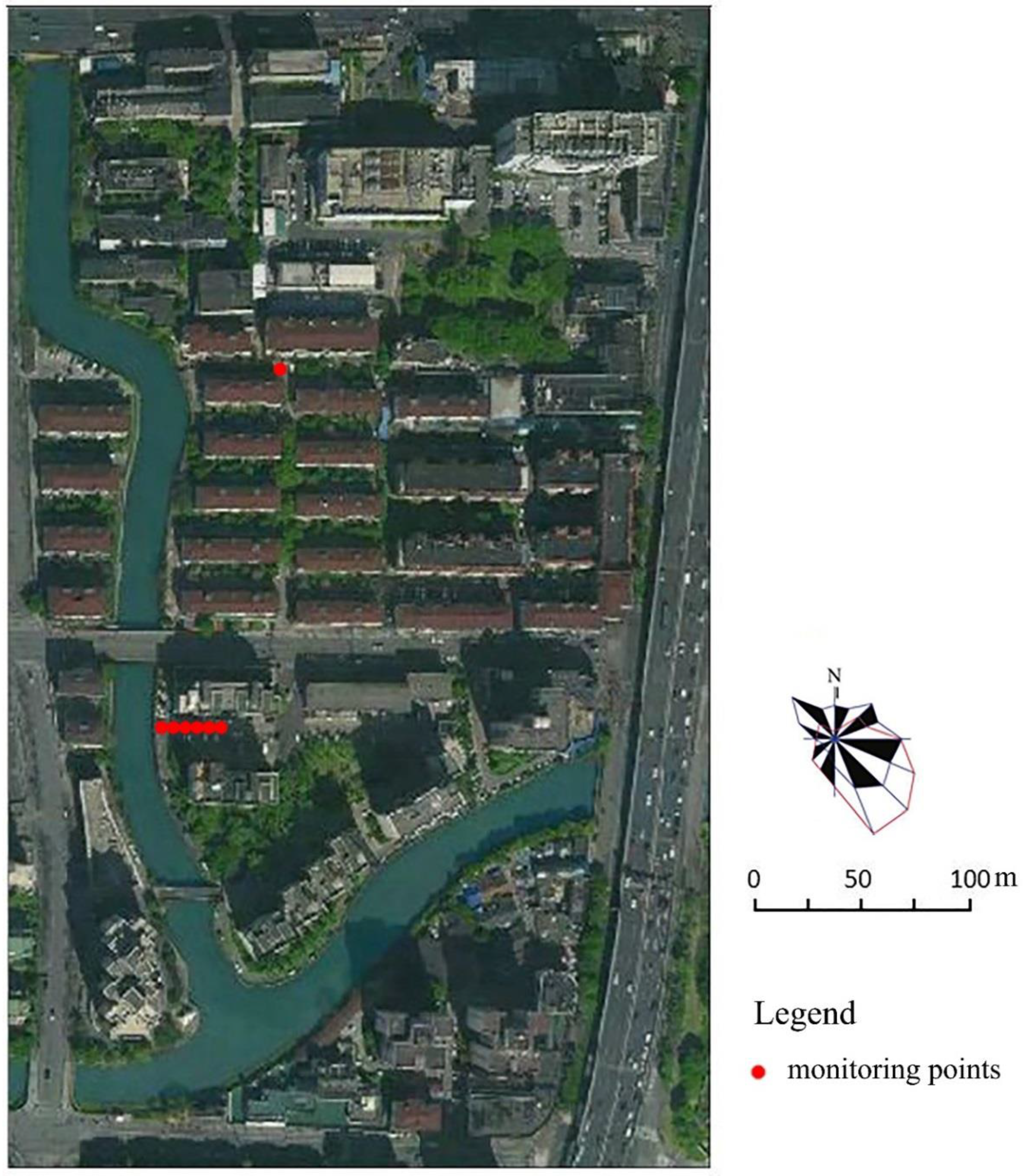
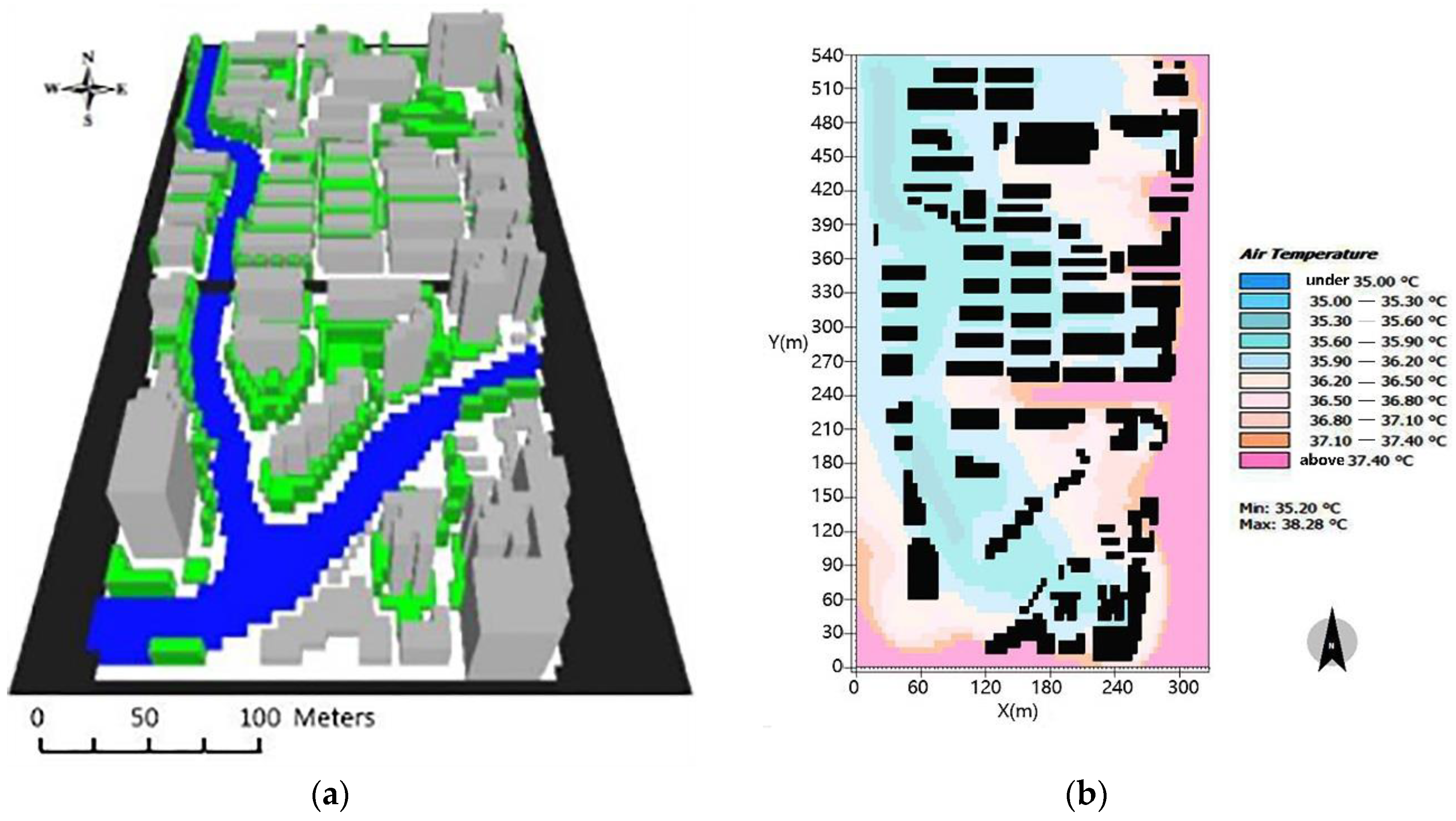
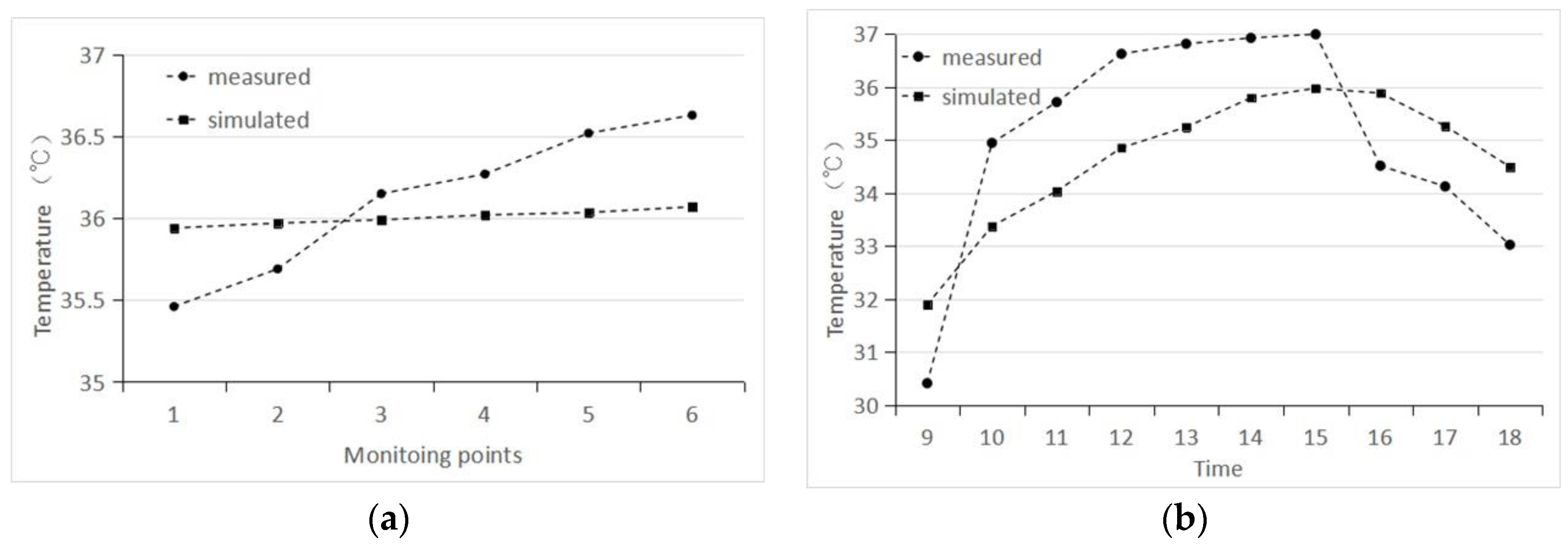
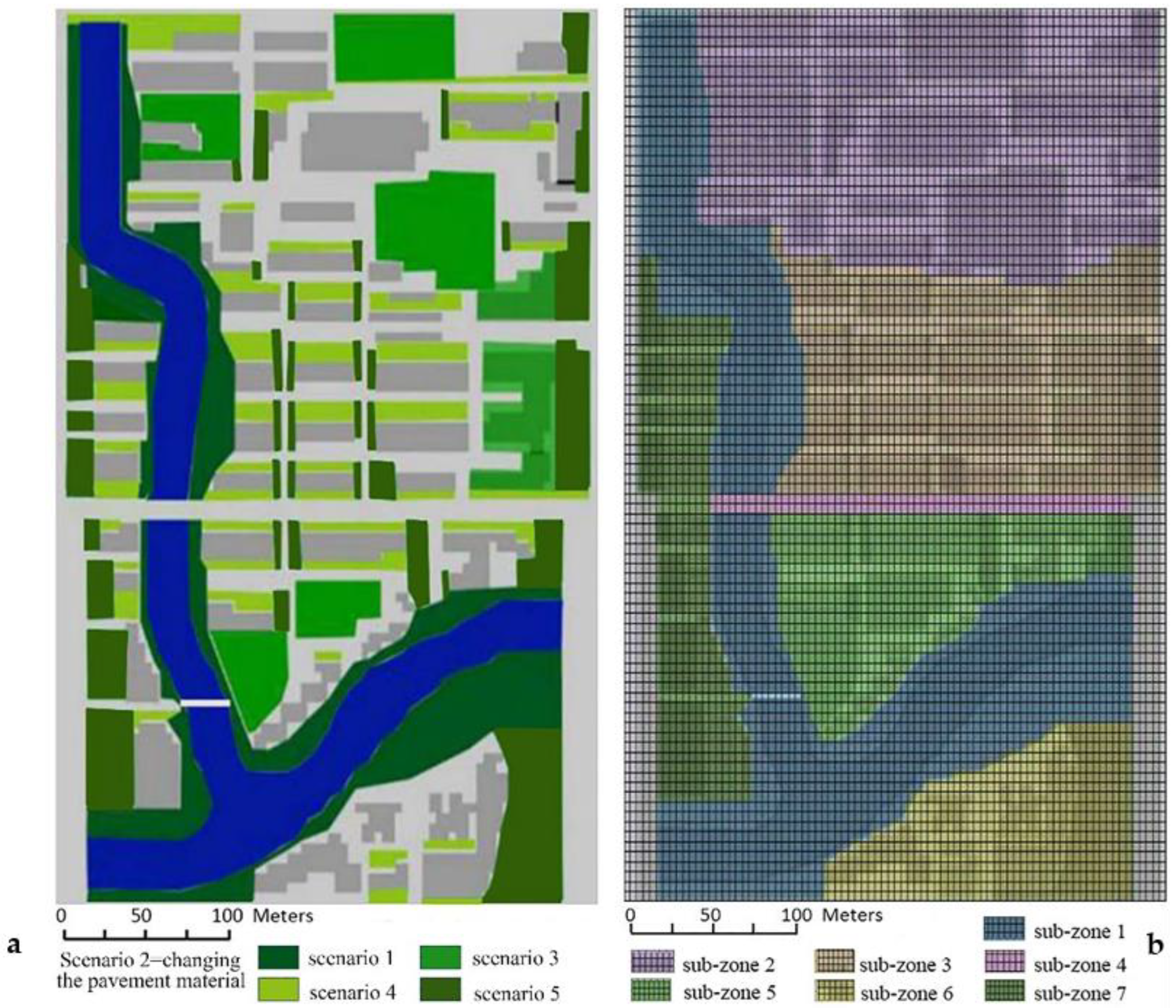

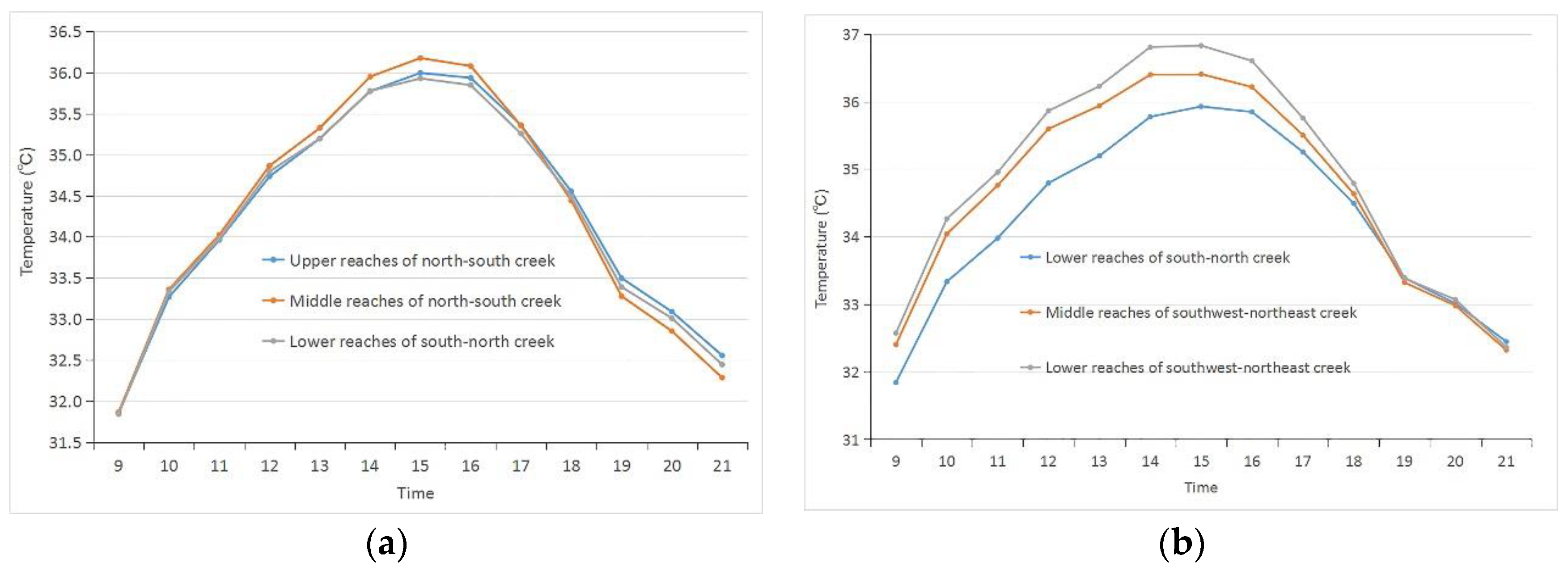



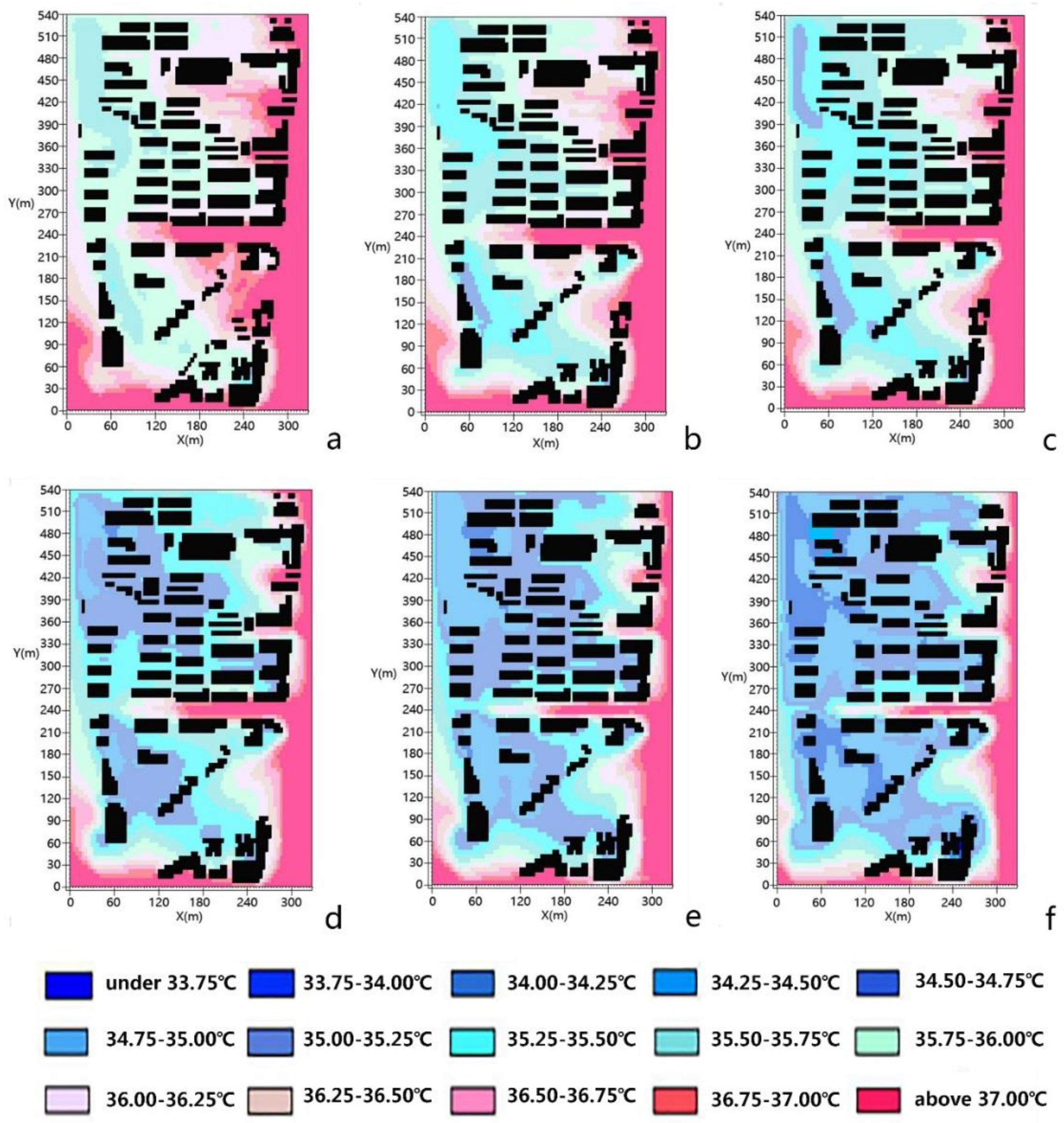
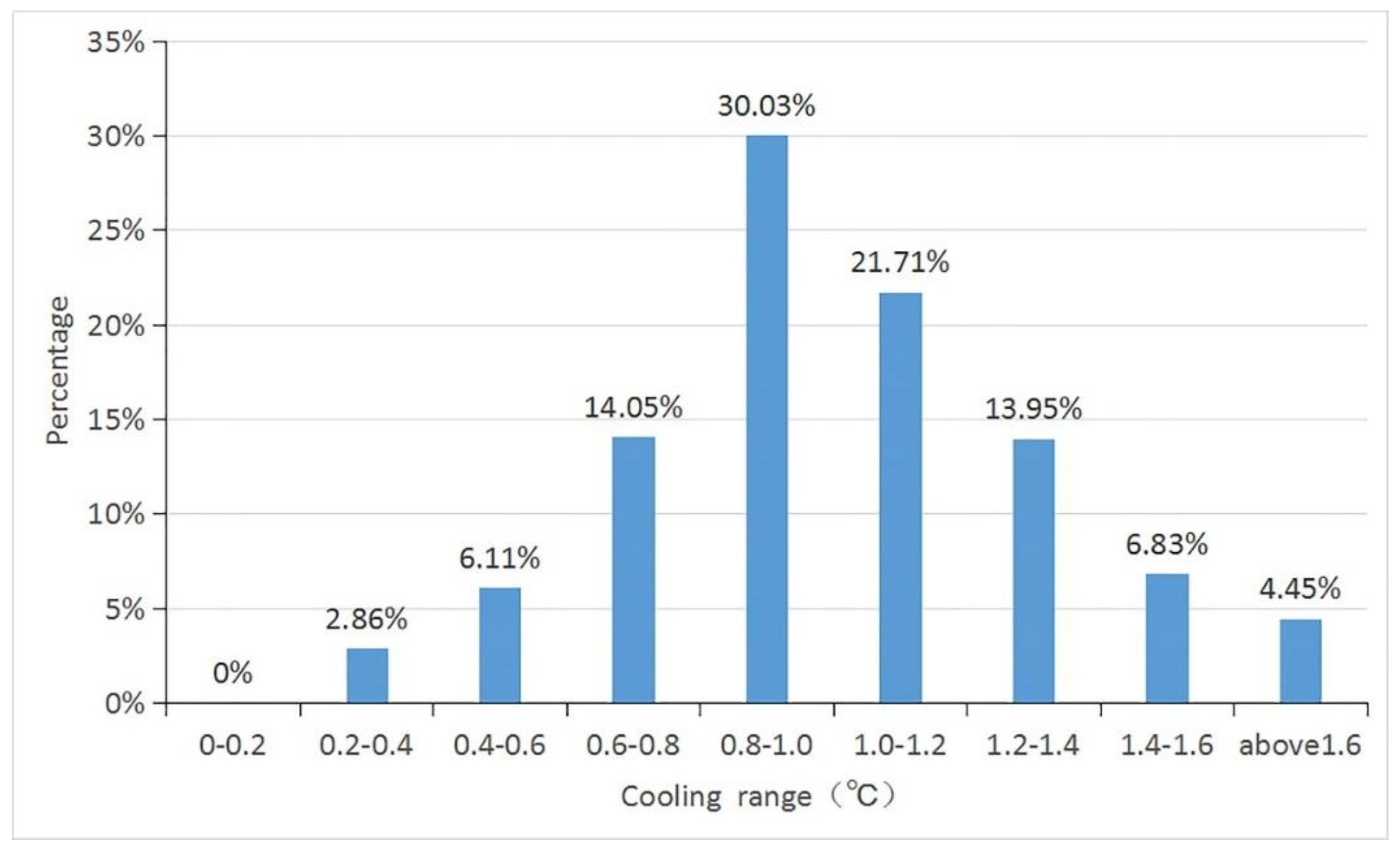
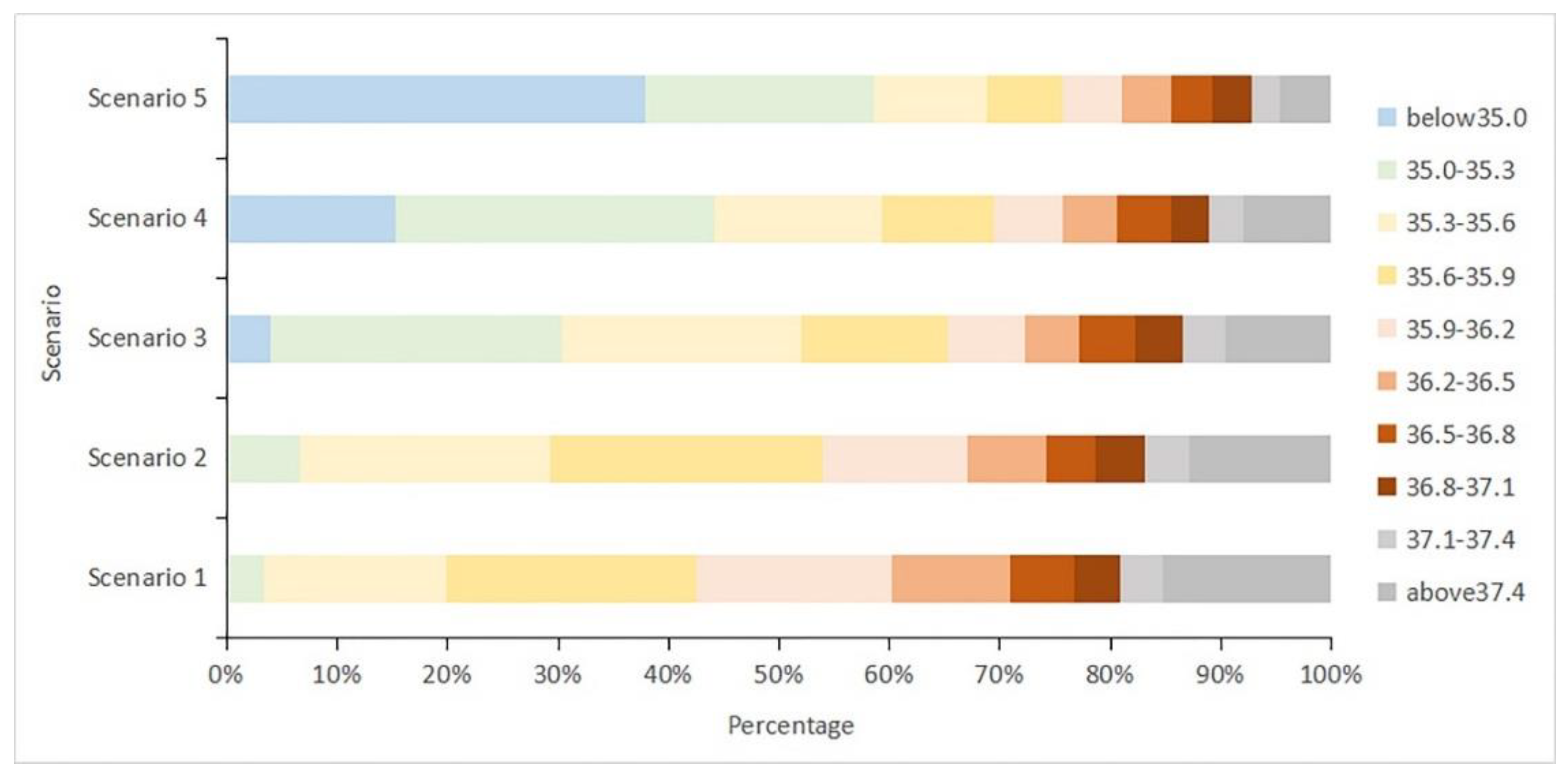

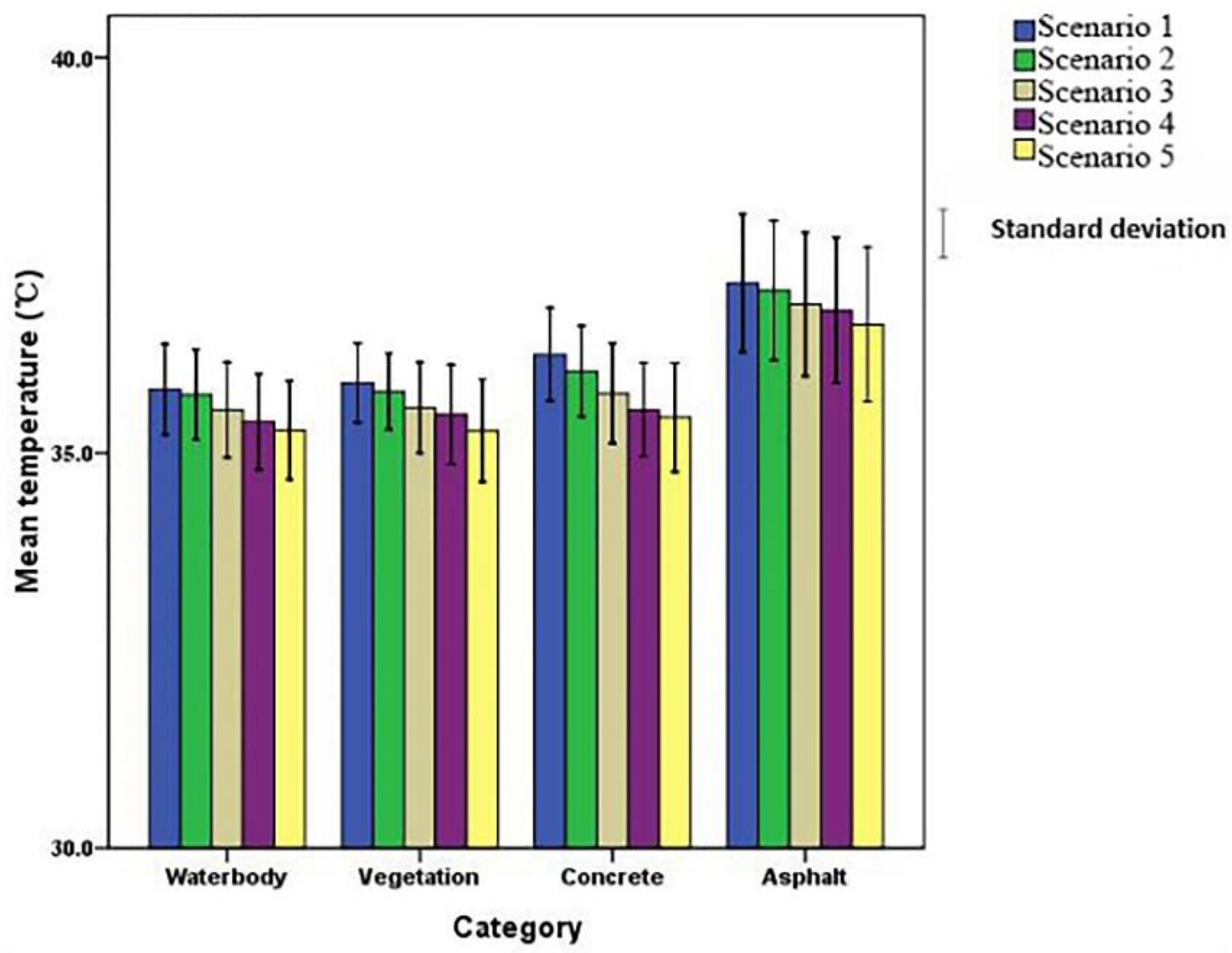
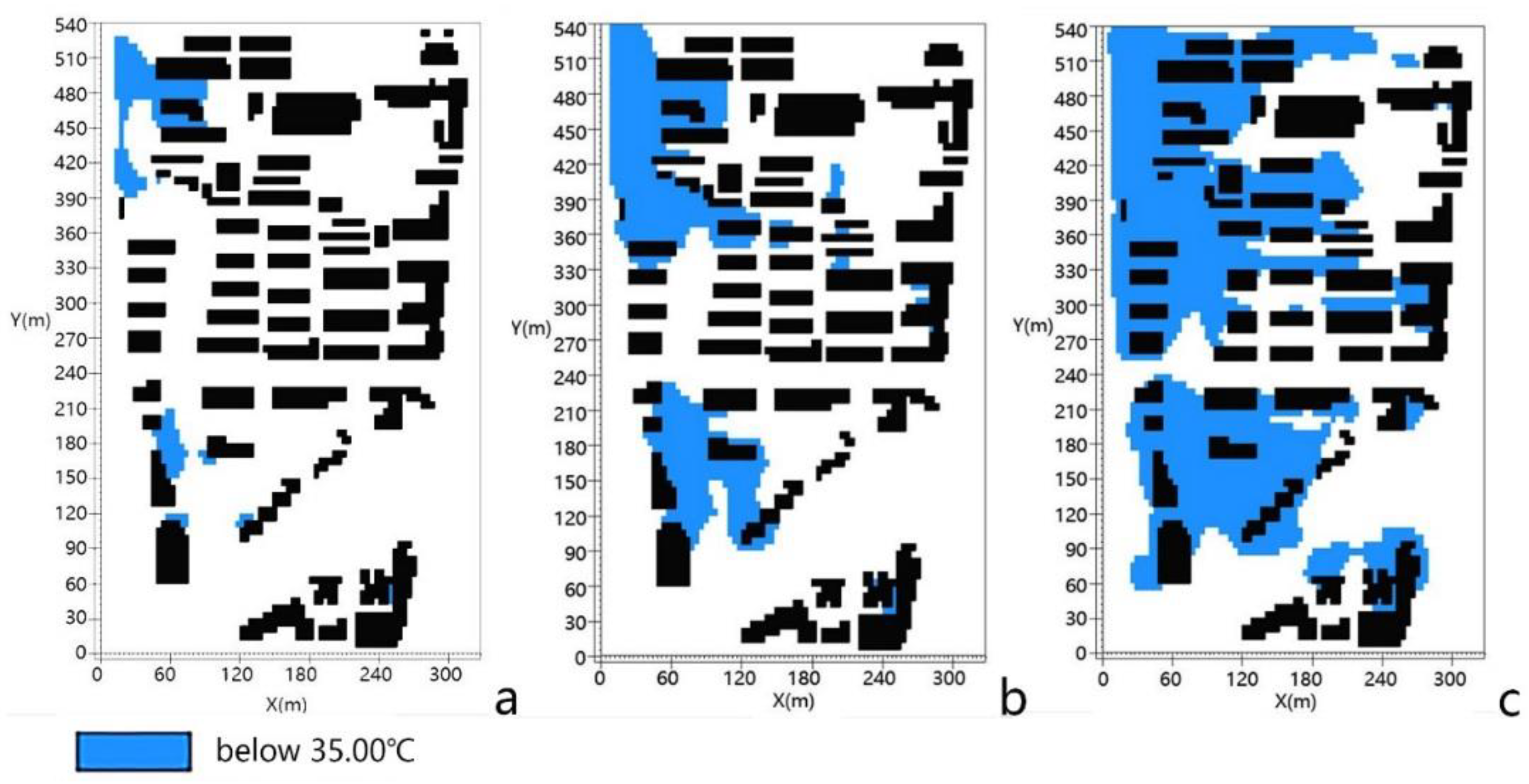
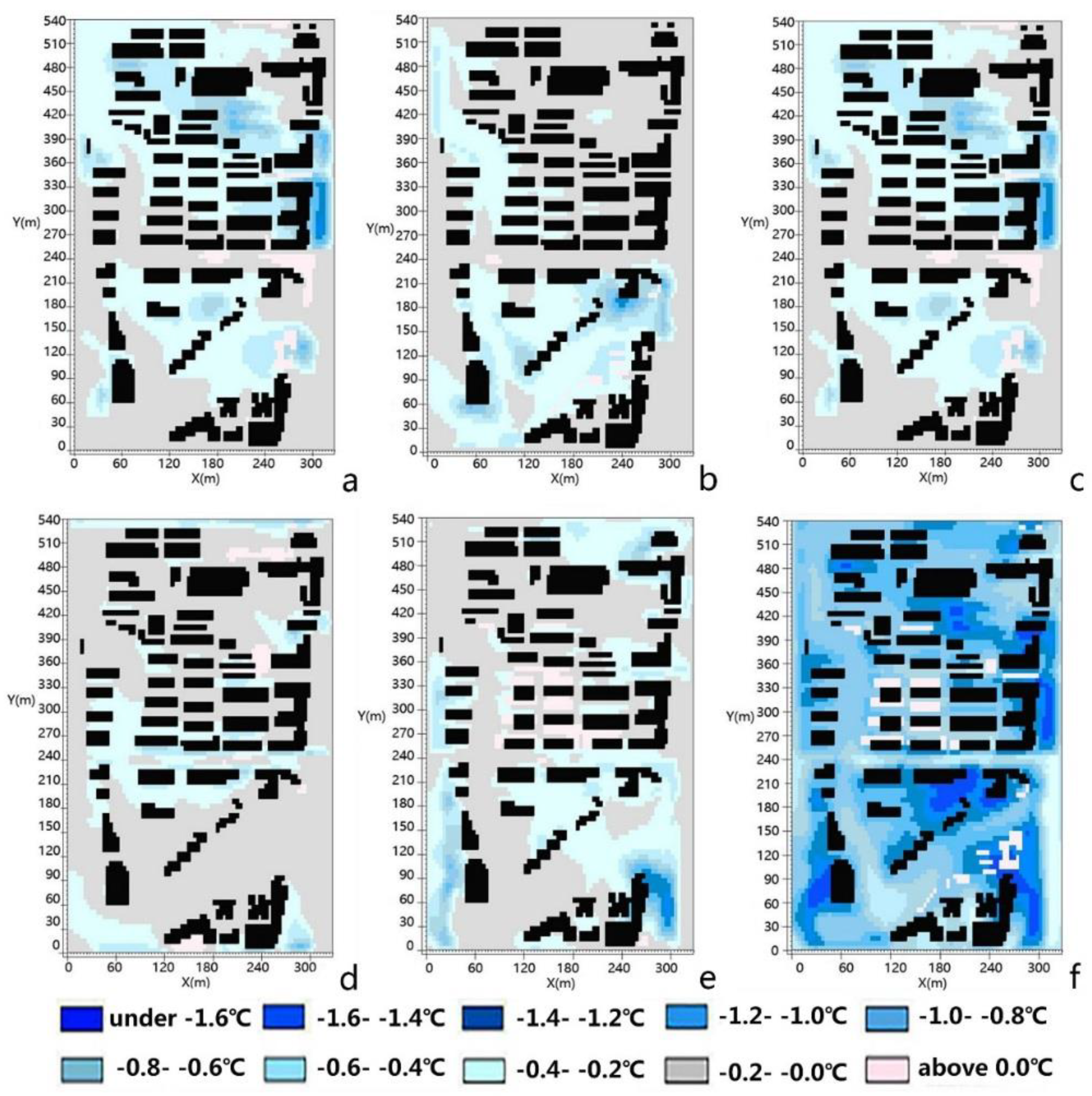

| Input Category and Parameter | Value(s) Used |
|---|---|
| Time and date | |
| Date | 2017.7.20 |
| Starting time | 4:00 |
| Simulated time | 24 h |
| Initial meteorological conditions | |
| Wind speed (10 m) | 5 m/s |
| Wind direction | 135° (from the west) |
| Roughness length | 0.01 |
| Temperature of incoming | 30 °C |
| Specific humidity (2500 m) | 7 g/kg |
| Relative humidity (2 m) | 89% |
© 2018 by the authors. Licensee MDPI, Basel, Switzerland. This article is an open access article distributed under the terms and conditions of the Creative Commons Attribution (CC BY) license (http://creativecommons.org/licenses/by/4.0/).
Share and Cite
Jiang, Y.; Song, D.; Shi, T.; Han, X. Adaptive Analysis of Green Space Network Planning for the Cooling Effect of Residential Blocks in Summer: A Case Study in Shanghai. Sustainability 2018, 10, 3189. https://doi.org/10.3390/su10093189
Jiang Y, Song D, Shi T, Han X. Adaptive Analysis of Green Space Network Planning for the Cooling Effect of Residential Blocks in Summer: A Case Study in Shanghai. Sustainability. 2018; 10(9):3189. https://doi.org/10.3390/su10093189
Chicago/Turabian StyleJiang, Yunfang, Danran Song, Tiemao Shi, and Xuemei Han. 2018. "Adaptive Analysis of Green Space Network Planning for the Cooling Effect of Residential Blocks in Summer: A Case Study in Shanghai" Sustainability 10, no. 9: 3189. https://doi.org/10.3390/su10093189
APA StyleJiang, Y., Song, D., Shi, T., & Han, X. (2018). Adaptive Analysis of Green Space Network Planning for the Cooling Effect of Residential Blocks in Summer: A Case Study in Shanghai. Sustainability, 10(9), 3189. https://doi.org/10.3390/su10093189




